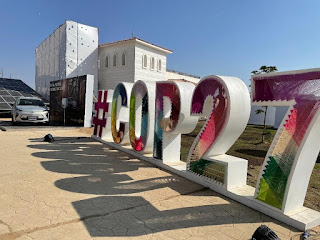INSIDE COP27
The following article by Alan Northcutt was published in the December 6th edition of the Waco Tribune Herald:
INSIDE COP27
Conference of the Parties 27 (COP27), Nov 6 through 20,2022, was the annual meeting of all nations on Earth, tasked with saving our world from the ravages of cataclysmic climate change. In a year in which one-third of Pakistan was submerged, a heatwave killed 16,000 in Europe, and Hurricane Ian was one of the costliest storms in world history, the critical role of this COP was evident. Having witnessed a major breakthrough at COP21 in Paris, the Friends of the Climate contingent approachedCOP27 in Egypt with hope.
The setting. Sharm El Sheikh is a beautiful, arid, subtropical city at the southern tip of the Sinai Peninsula, on the Red Sea, at the mouth of the Gulf of Aqaba. On the “bay of the wise,” Sharm is a popular destination for tourists and large conventions. The area’s rich biodiverse coral reefs, bathed in light green crystalline water, were a constant reminder of the vital importance of the COP’s work to limit ocean warming. The Egyptian government quickly created a “green” Sharm: electric buses transported attendees, a few electric vehicle (EV) charging stations were installed, the lavish hotels were adding solar panels, and the International Hospital was “eco-friendly.” The summit grounds were completely unlike those of COPs in Paris and Madrid. They were expansive and lush, with meeting halls, abundant climate sculptures, interactive displays, pools, bridges, fountains, and light shows. Although Egypt’s motive may have been to dazzle the world, the setting was warm, inviting, and inspirational.
Freedom of speech. Protest was severely limited at this COP, although this may partially relate to the 2005 terrorist attack in Sharm that killed 88 people. Armed police and surveillance were widespread, demonstrations were officially allowed distant from the summit only, and pre-COP arrests were numerous. For the first time in three COPs, we did not participate in a protest.
Attendees. Some 35,000 participants included heads of state, diplomats, negotiators, climate scientists, business leaders, volunteers, activists, and other members of civil society. Being part of huge throngs of individuals, all devoted to the climate struggle, filled our small delegation with feelings of solidarity and optimism. Unfortunately, about 600 fossil fuel representatives were also present, with influence designed to delay needed limitations on fossil fuels. We also encountered individuals who inspired us:
- (BRT). As we lingered in the auditorium after the panel, he approached us for a private discussion oEgypt’s Minister of Transportation spoke during a high-level panel discussion on Bus Rapid Transit f BRT, sharing his knowledge with openness and humility.
- Musician AY Young gave a surprise performance at an ocean seminar—with a roaring audience response of approval. His “Battery Tour” of over 800 shows, is powered fully by renewable energy and lithium young lawyer from Spain, sitting next to us in a solutions lecture, introduced herself. She had given up a comfortable job in environmental law to form a start-up company providing Biochar for farm ions. Concert proceeds help provide solar power to villages lacking reliable access to electricity.
- Aers’ fields, yielding carbon sequestration and improved soil fertility.
The results. COP negotiations are extremely detailed and tedious, requiring consensus of almost 200 nations, with every word subject to debate. Although I agree with activists that we need immediate bold action, I also understand the practical difficulty of designing documents acceptable to all parties. The following were completed or inaugurated at COP27:
- Loss and Damage. After 30 years of discussions, the world’s wealthy nations agreed to provide a fund for climate damages suffered by the developing countries. This clearly represents climate justice, since the wealthy nations’ greenhouse gases (GHGs) have injured poor countries, which have miniscule emissions. Although European nations have pledged $300 million for loss and damage, the formal details of the fund will be developed over the next two years.
- Climate TRACE. VP Al Gore announced this new project (climatetrace.org), which uses satellites/direct measurement/artificial intelligence to provide an amazing global map, showing thousands of GHG emission sites and their amounts for 2021. The top emitters in the Waco area are: Woodway Cement Plant, 865kiloton CO2 equivalent; City of Waco landfill, 165kiloton CO2 equivalent; Lacy-Lakeview Regional Disposal Facility, 81kiloton CO2 equivalent; Dairy 56 cattle feedlot, 5.4kiloton CO2 equivalent; Dairy 16 cattle feedlot, 4.1 kiloton CO2 equivalent; and Waco Regional Airport, 25.1 ton CO2 equivalent. Climate TRACE promises to be a powerful tool to ensure the accuracy of GHG emission reduction claims.
- GHG Emissions Reduction. Sadly, the COP27 document essentially repeats the language of COP26, calling for “phase-down” of coal use, but not of oil and gas. More than 80 countries demanded the phase-down of all fossil fuels, but this was blocked by major oil producers, including Canada, Saudi Arabia, and China.
- Nationally Determined Contributions (NDCs) Increase. The Glasgow summit called for annual stocktake of each nation’s emissions and an increase (rachet) in their reduction pledge. Tragically, only 24 of about 200 nations complied with this requirement.

Comments
Post a Comment